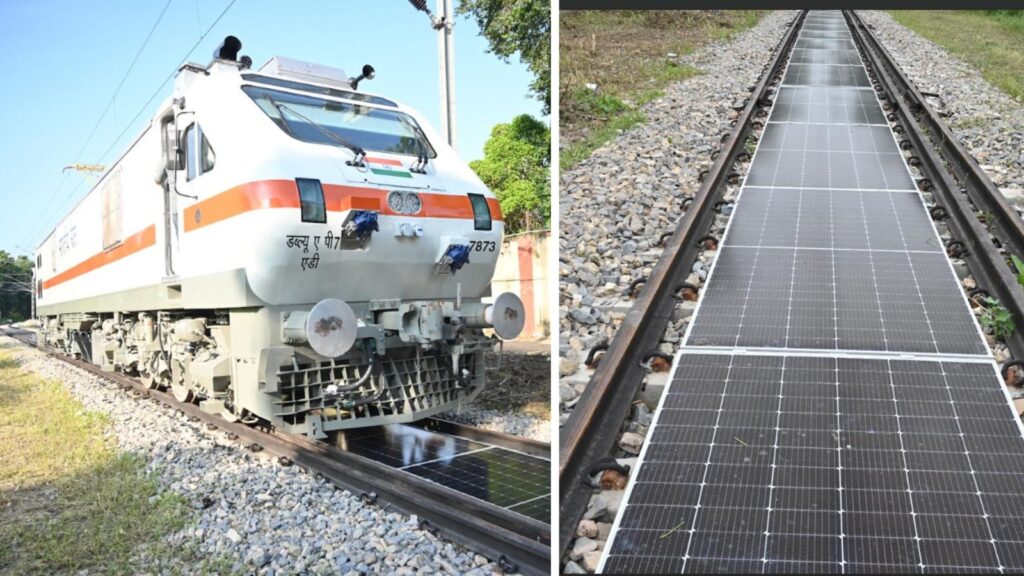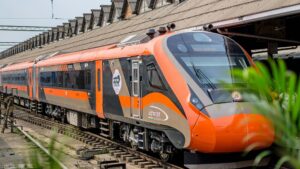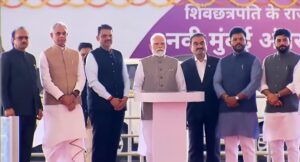Varanasi Pioneers Solar Innovation: India’s First Removable Solar Panels Installed Between Railway Tracks

Varanasi Pioneers Solar Innovation: India’s First Removable Solar Panels Installed Between Railway Tracks
In a groundbreaking move toward sustainable transport and energy innovation, Indian Railways has introduced the country’s first-ever removable solar panel system installed directly between railway tracks. This pioneering project, launched at Banaras Locomotive Works (BLW) in Varanasi, Uttar Pradesh, marks a significant leap in the national effort to reach net-zero carbon emissions.
As part of a pilot initiative, BLW has successfully deployed a 70-meter stretch of solar panels—28 in total—between the rails on Line No. 19 of its workshop. With an installed capacity of 15 kilowatt peak (KWp), this novel installation is a major step forward in blending clean energy technology into India’s vast railway infrastructure.
🚆 Indian Railways marks a historic first!
— Ministry of Railways (@RailMinIndia) August 18, 2025
Banaras Locomotive Works, Varanasi commissioned India’s first 70m removable solar panel system (28 panels, 15KWp) between railway tracks—a step towards green and sustainable rail transport. pic.twitter.com/BCm2GTjk7O
The Ministry of Railways shared the accomplishment on social media, posting:
“Banaras Locomotive Works, Varanasi, has introduced India’s first 70-meter removable solar panel setup—comprising 28 panels and a 15 KWp capacity—between railway tracks. A major milestone in our mission for eco-friendly and sustainable rail transport.”
Unlike conventional solar farms that require dedicated land, this initiative cleverly uses the space between railway tracks, eliminating the need for land acquisition. The panels are carefully designed for placement between sleepers—the concrete beams supporting the rails—without affecting train movement.
Engineered with an indigenous mounting system, the panels are not only highly durable and efficient but also fully detachable, making track maintenance seamless and seasonal adaptation possible.
According to BLW, “These panels are built to withstand the rigors of railway operations while offering the flexibility to be easily removed when needed. Their design ensures no disruption to train schedules.”
Technical Highlights
- Track Length Covered: 70 meters
- Installed Capacity: 15 KWp
- Number of Panels: 28
- Power Density: 240 KWp/km
- Energy Output: 960 units per km per day
Each solar panel is a robust unit, measuring 2278 mm × 1133 mm × 30 mm, and weighs 31.83 kg. They are fitted with 144 half-cut mono P-type PERC bifacial cells and boast a module efficiency of 20.15%. The panels feature an IP68-rated junction box, multi-bus bar technology, and a transparent substrate with anodized framing for durability.
On the electrical side, each module delivers:
- Power Output: 602 watts
- Maximum Voltage (Vmp): 41.78V
- Current (Imp): 13.24A
- Open Circuit Voltage (Voc): 49.71V
- Short Circuit Current (Isc): 15.16A
To tackle the challenges of railway vibrations and environmental exposure, the installation team employed rubber mounting pads to absorb shocks and epoxy adhesives for secure fixing onto concrete sleepers. For maintenance or emergencies, each panel can be removed using four stainless steel Allen bolts, making disassembly quick and tool-friendly.
Indian Railways operates across a colossal 1.2 lakh kilometers of track. With this new approach, officials estimate that if deployed more widely—especially in yard lines—the project could yield 3.21 lakh units of energy per kilometer annually, without disturbing existing land usage.
This translates to a power density of 220 KWp/km and daily energy generation of 880 units/km, offering vast potential for scale across the railway ecosystem.
General Manager Naresh Pal Singh, who inaugurated the project on Independence Day, lauded the BLW team, especially Chief Electrical Service Engineer Bhardwaj Chaudhary, for developing this forward-thinking energy solution.
Singh remarked, “This project is a breakthrough in harnessing solar power within railway operations. It not only broadens our renewable energy use but also sets a practical model for future implementation throughout Indian Railways.” He added that it complements BLW’s ongoing rooftop solar power efforts, creating a comprehensive green energy environment within the premises.












